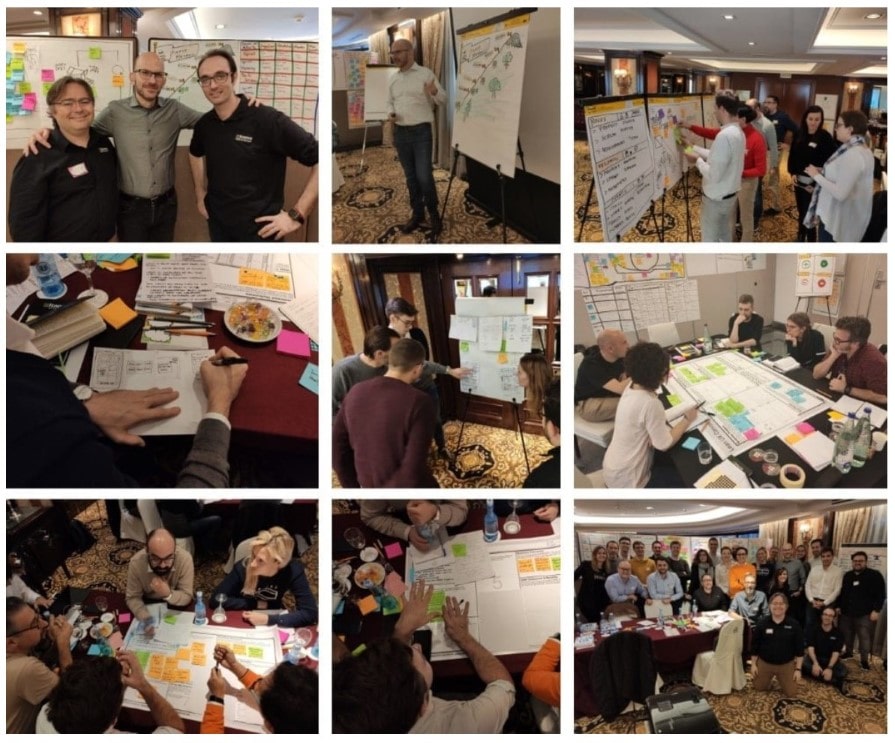Professional Scrum with User Experience
Live Virtual Class, May 6-15, 2025
Class Overview
Professional Scrum with UX (virtual de tardes)
- Fechas: 6-8-13-15 de Mayo (2025)
- Lugar: Curso Virtual
- Horario: 3am - 7pm CET (España), 4 sesiones x 4 horas
- Idioma: Español
- Formato: Curso virtual con Webex y Mural
- Precio:
- Precio general: 1.050€ (+ IVA en España)*
- Precio anticipado 950€ (antes 22/05/25, + IVA en España)*
- Medios de pago: Tarjeta de crédito o transferencia.
- El precio incluye:
- Curso y materiales oficiales
- Dos intentos del examen de certificación PSU
- 14 PDU para certificados PMI
* el IVA no aplica a compañías registradas como operadores intra-comunitarios y personas o compañías de fuera de Europa.
Class Details
Taught By
Language
Spanish
Delivery Method
Date
Class Format
TraditionalPartner
ITNOVEMore Information

Este curso te permitirá sacar lo mejor de Scrum y UX
Este curso práctico de 2 días te permitirá aprender a integrar las mejores prácticas del UX moderno (¡ UX es más que UI !) en el proceso de desarrollo. Aprenderás que, aunque el trabajo de diseño puede parecer a veces lento y poco integrable en los Sprints cortos y sus eventos, realmente sí puede hacerse bien y sacar ventaja de dicha integración. Aprende técnicas UX que encajan muy bien en Scrum, y practica estas técnicas durante la clase en equipos autoorganizados.
El taller PSU es de nivel avanzado y de perfeccionamiento, asumiendo que se tiene un conocimiento básico de Scrum.
Curso co-creado con los autores de Lean UX
Scrum.org y sus Professional Scrum Trainers han trabajado con Jeff Gothelf and Joshua Seiden, los autores del libro Lean UX, en la creación de este curso, aprovechando su experiencia y conocimiento.
¿Qué conseguiré al hacer esta formación?
Durante este curso aprenderás:
- Como incluir a los especialistas de UX dentro de Scrum Teams transversales (cross-functional).
- Como incluir y gestionar el trabajo de UX en un único Backlog de producto.
- Como equilibrar el trabajo de descubrimiento y desarrollo dentro de un Equipo Scrum.
- Como los Equipo Scrum pueden obtener feedback de cliente durante el Sprint.
- Como asegurar que la satisfacción del cliente forme parte de los eventos Scrum y de la toma de decisiones.
- Como interpretar la "Definition of Done" en un mundo de aprendizaje continuo.
- Como el UX puede ayudar a tomar mejores decisiones de desarrollo.
Temas del curso:
- Entender como Scrum y UX aumentan el aprendizaje continuo.
- Definirn el trabajo como problemas del usuario a resolver.
- Priorizar los impactos sobre el tamaño de los productos.
- Gestión del trabajo de UX en Scrum
- Foco en los usuarios.
- Hipótesis.
- Gestión del trabajo UX de ciclo largo.
- Experimentación.
- Apéndices: Design Sprints.
Algunas fotos del curso

Certificación Professional Scrum with User Experience (PSU):
- Esta formación te cualifica para realizar el examen de certificación Professional Scrum with UX (PSU) de Scrum.org.
- Si realizas el examen en dos semanas a partir del curso y suspendes, tendrás un reintento gratuito de Scrum.org.
- Scrum.org te enviará el certificado PSU y te incluirá en un directorio público de poseedores del certificado PSU.
Sobre los formadores
Alex Ballarin se ha dedicado al desarrollo de software desde 1999, y desde 2004 trabaja ayudando a equipos y organizaciones enteras a mejorar sus resultados, primero en IBM Rational y posteriormente en ITNOVE.
En 2009 redescubrió la agilidad, para transformar las organizaciones tradicionales basadas en planes, procesos, jerarquías y KPIs a organizaciones innovadoras que obtienen mejores resultados gracias a la comunicación, la orientación a valor y la inteligencia colectiva de todos sus miembros.
Alex ha formado en agilidad, Scrum y DevOps a cientos de profesionales en decenas de cursos, en los que ha aprendido de los asistentes y ha transformado su metodología docente desde la transmisión de conocimientos hacia la habilitación de los profesionales como agentes del cambio organizativo. Colabora con Scrum.org desde 2014 y es Professional Scrum Trainer desde 2016.
Además desarrolla otras actividades como:
- Dirige el postgrado Agile, DevOps y Lean IT en la UPC School.
- Coordina el Barcelona Scrum Meetup.
Certificaciones Professional Scrum del instructor

Hemos formado a personas y equipos de estas y otras empresas

Contenidos del curso detallados (en inglés)
Scrum and UX Fundamentals
This introductory chapter sets the context for the remaining of the course. These topics will be discussed through class discussion and group exercises:
- The Scrum Framework components, rules, principles and values.
- What is UX and UX Design?
- What is Lean UX?
- How to align Scrum and UX?
- Why are UX and Agile converging now?
Defining the work as problems to solve
This chapter introduces a basic principle for the Agile software development with a user experience design approach: defining the work as problems to solve.
The Lean UX Canvas is also introduced. This tool will be used throughout the course as a backbone to work on the case study.
These topics will be discussed through class discussion and group exercises:
- How to take better decisions in product development.
- What are the outcomes of defining the work as problems to solve.
- The Business Problem Statement.
Scrum deep dive
This chapter delves into the Scrum Framework. This proves useful for both the Product and UX roles and also Scrum Master or Agile Coaches that have not attended a specific Scrum Master course.
These topics will be discussed through class discussion and group exercises:
- Review the reviews and responsibilities of the Scrum roles.
- Review what is inspected and adapted in Scrum events and activities.
- Review how Scrum artifacts contribute to transparency and correct decision-making.
- Understand what is the Product Backlog, how to use it correctly and the importance of refinement.
- Understand the importance of the Sprint Goal and how to use if effectively.
- Understand the concept of Done, the Definition of Done, and the impact of UX in them.
Outcomes over outputs
This chapter focuses in another key principle for successful digital product delivery: outcome for users is more important that the output (product) size.
These topics will be discussed through class discussion and group exercises:
- Agile Manifesto, products and outcomes.
- The power of focusing on results.
- Challenging the assumptions chain: activities, product, outcomes and impacts.
- Outcomes are decided by users.
- Value for the Business vs the user.
- Lean funnels and Pirate metrics.
- The only metric that matters.
- How to declare assumptions and outcomes in the Lean UX Canvas.
- What assumptions should be checked and what shouldn’t.
Managing UX work in Scrum
This chapter is divided in two parts because its importance.
The first part reviews how to integrate UX and development activities:
- Common issues integrating UX into Scrum.
- What is Dual-Track Agile and how to perform it correctly.
- How to write flexible and ux-oriented user stories.
- Patterns and anti-patterns managing Scrum and UX work: one backlog or two?
The second part focuses on providing guidelines on how to adapt the UX work to fit within Sprints:
- Cualitative and cuantitative research during Sprints.
- Using a common board to align UX and development work.
- Value risk boards.
- How to align Sprints with other design work such as brand design or Visual Design Systems.
- How to shape UX work as Product Backlog items.
Focus on users
This chapter explores concepts and techniques to place the user at the center of decision-making.
These topics will be discussed through class discussion and group exercises:
- Proto-personas: how to use them? what benefit do they provide in Agile?
- Different flavours of Personas, Marketing, Proto and Buyer.
- How to declare user assumptions and benefits in Lean UX Canvas
Solution possibilities
This chapter explores concepts and techniques to find solutions to the user problems.
These topics will be discussed through class discussion and group exercises:
- How to use the Solutions box in Lean UX Canvas.
- How to design, implement and validate the solution’s design.
- What effort is needed at each step of the solution design, validation and growth.
Hyphotesis
This chapter focuses on how to validate existing assumptions, created previously in the Lean UX Canvas.
These topics will be discussed through class discussion and group exercises:
- What is the purpose of creating hyphotesis?
- How to write effective hyphotesis?
- How do hyphotesis drive experimentation? Do we need to add metrics to hyphotesis?
Experimentation
This chapter focuses on experimentation to avoid cost overruns and reworks, presenting tools and techniques to plan and perform experimentation.
These topics will be discussed through class discussion and group exercises:
- How do we make decisions to develop features? What evidences do we have?
- Can we have learning items in the Product Backlog?
- How learning drives the Backlog prioritization?
- How to decide when to experiment?
- What is the Truth Curve for experimentation?
- Types of experiments: Landing Page, Feature Fake, Wizard of Oz, Papel, etc.
- What is really a MVP? What are myths about MVP? How to implement a MVP?
- What is Emergent UX?
Preguntas frecuentes
- ¿Qué se incluye en el precio? El precio incluye los materiales del curso, dos intentos del examen PSU I, duradero de por vida con Scrum.org.
- ¿Cómo es el examen PSU I? El examen se hace via web, tiene 60 preguntas tipo test con multiple respuesta y se debe completar en 60 minutos. El aprobado está en el 85%.
- ¿Cuál es el horario del curso? De 9.30h a 13.30h los 4 días del curso.
- ¿Cuanta gente asistirá? Un máximo de 16 personas, normalmente menos, para asegurar una experiencia premium.
- ¿Cómo debería prepararme para el curso? La preparación básica incluye leer la Scrum Guide. Adicionalmente se puede leer el libro Lean UX de Jeff Gothelf y Josh Seiden.
- Si no estoy seguro de tener la experiencia apropiada para el curso, ¿qué puedo hacer? Contacta con el formador y te acosejaremos.
- ¿Puedo reclamar PDU del PMI por asistir al curso? Sí. Puedes reclamar 14 PDU.
- ¿Puedo pagar con tarjeta? Sí, escogiendo Pago con tarjeta durante el proceso de registro. Se obtendrá automáticamente una factura.
- ¿Puedo pagar por transferencia y obtener factura proforma? Sí, escogiendo Pago con transferencia durante el proceso de registro.
Contacta con nosotros
¿Tienes dudas? ¿Podemos ayudarte? Puedes contactar con nosotros en:
Teléfono: +34 623 195 990
Email: info@itnove.com
Web: http://www.itnove.com
Linkedin: https://www.linkedin.com/in/alexballarin
Venue


